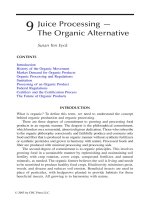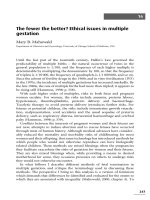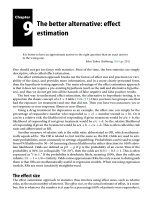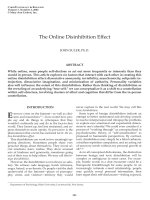The better alternative - effect estimation
Bạn đang xem bản rút gọn của tài liệu. Xem và tải ngay bản đầy đủ của tài liệu tại đây (167.15 KB, 10 trang )
Chapter
9
The better alternative: eect
estimation
It is better to have an approximate answer to the right question than an exact answer
to the wrong one.
John Tukey (Salsburg, 2001; p. 231)
One should not get too fancy with statistics. Most of the time, the best statistics are simply
descriptive, oen called eect estimation.
e eect estimation approach breaks out the factors of eect size and precision (or vari-
ability of the data), and provides more information, and in a more clearly presented form,
than the hypothesis-testing approach. e main advantage of the eect estimation approach
is that it does not require a pre-existing hypothesis (such as the null and alternative hypothe-
ses), and thus we do not get into all the hazards of false negative and false positive results.
e best way to understand eect estimation, the alternative to hypothesis-testing, is to
appreciate the classic concept of a 2 × 2table(Table 9.1). Here you have two groups: one that
had the exposure (or treatment) and one that did not. en you have two outcomes: yes or
no (response or non-response; illness or non-illness).
Using a drug treatment for depression as an example, the eect size can simply be the
percentage of responders: number who responded (a + c) ÷ number treated (a + b). Or it
can be a relative risk: the likelihood of responding if given treatment would be a/a + b; the
likelihood of responding if not given treatment would be c/c + d. So the relative likelihood
of responding if given the treatment would be a/a + b ÷ c/c + d. is is oen called the risk
ratio and abbreviated as RR.
Another measure of relative risk is the odds ratio, abbreviated as OR, which mathemat-
icallyequalsad/bc.eORisrelatedto,butnotthesameas,theRR.Oddsareusedtoesti-
mate probabilities, most commonly in settings of gambling. Probabilities can be said to range
from 0% likelihood to 50−50 (meaning chance likelihood in either direction) to 100% abso-
lute likelihood. Odds are dened as p/1 − pifpistheprobabilityofanevent.usifthe
probability is 50% (or colloquially “50–50”), then the odds are 0.5/1 − 0.5 = 1. is is oen
expressed as “1 to 1.” If the probability is absolutely likely, meaning 100%, then the odds are
innite: 1/1 − 1 = 1/0 = Innity. Odds ratios approximate RRs; the only reason to distinguish
them is that ORs are mathematically useful in regression models. When not using regression
models, RRs are more intuitively straightforward.
The eect size
e eect estimation approach to statistics thus involves using eect sizes, such as relative
risks,asthemainnumberofinterest.eeect size, or the actual estimate of eect, is a num-
ber; this is whatever the number is: it may be a percentage (68% of patients were responders),
Section 3: Chance
Table 9. 1. The epidemiological two-by-two table
Outcome: yes Outcome: no
Exposure: yes a b a + b
Exposure: no c d c + d
a+c b+d
or an actual number (the mean depression rating scale score was 12.4), or, quite commonly,
a relative risk estimate: risk ratios (RRs) or odds ratios (ORs).
Many people use the word eect size to mean standardized eect size,whichisaspecial
kind of eect estimate. e standardized eect size, called Cohen’s d,istheactualeectsize
described above (such as a mean number) divided by the standard deviation (the measure of
variability). It produces a number that ranges from 0 to 1 or higher, and these numbers have
meaning, but not unless one is familiar with the concept. Generally, it is said that a Cohen’s d
eectsizeof0.4orlowerissmall,0.4to0.7medium,andabove0.7large.Cohen’sdisauseful
measure of eect because it corrects for the variability of the sample, but it is less interpretable
sometimes than the actual unadulterated eect size. For instance, if we report that the mean
Hamilton depression rating scale score (usually above 20 for severe depression) was 0.5 (zero
being no symptoms) aer treatment, we can know that the eect size is large, without needing
to divide it by the standard deviation and get a Cohen’s d greater than 1. Nonetheless, Cohen’s
d is especially useful in research using continuous measures of outcome (such as psychiatric
rating scales) and is commonly employed in experimental psychology research.
Other important estimates of eect, newer and more relevant to clinical psychiatry, is the
number needed to treat (NNT) and the number needed to harm (NNH). is is a way of trying
to give the eect estimate in a clinically meaningful way. Let us suppose that 60% of patients
responded to a drug and 40% to placebo. One way to express the eect size is the RR of 1.5
(60% divided by 40%). Another way of looking at it is that the dierence between the two
groups is 20% (60% − 40%). is is called the absolute risk reduction (ARR). e NNT is the
reciprocal of the ARR, or 1/ARR, in this case 1/0.20 = 5. us, for this kind of 20% dierence
between drug and placebo, clinically we can conclude that we need to treat ve patients with
the drug to get benet in one of them. Again, certain standards are needed. Generally, it is
viewed that an NNT of 5 or less is very large, 5–10 is large, 10–20 is moderate, above 20 is
small, and above 50 is very small.
A note of caution: this kind of abstract categorization of the size of the NNT is not exactly
accurate. e NNT by itself may not fully capture whether an eect size is large or small. Some
authors (Kraemer and Kupfer, 2006) note, for instance, that the NNT for prevention of heart
attack with aspirin is 130; the NNT for cyclosporine prevention of organ rejection is 6.3; and
the NNT for eectiveness of psychotherapy (based on one review of the literature) is 3.1 Yet
aspirin is widely recommended, cyclosporine is seen as a breakthrough, and psychotherapy
is seen as “modest” in benet. e explanation for these interpretations might be that the
“hard” outcome of heart attack may justify a larger NNT with aspirin, as opposed to the
“so” outcome of feeling better aer psychotherapy. Aspirin is also cheap and easy to obtain,
while psychotherapy is expensive and time-consuming (similarly, cyclosporine is expensive
andassociatedwithmanymedicalrisks).
Number needed to treat provides eect sizes, therefore, which need to be interpreted in
the setting of the outcome being prevented and the costs and risks of the treatment being
given.
62
Chapter 9: The better alternative: effect estimation
e converse of the NNT is the NNH, which is used when assessing side eects. Similar
considerations apply to NNH, and it is calculated in a similar way as the NNT. us, if an
antipsychotic drug causes akathisia in 20% of patients versus 5% with placebo, then the ARR
is 15% (20% − 5%), and the NNH is 1/0.15 = 6.7.
The meaning of condence intervals
Jerzy Neyman, who developed the basic structure of hypothesis-testing statistics
(Chapter 7), also advanced the alternative approach of eect estimation with the concept of
condence intervals (CIs) (in 1934).
e rationale for CIs stems from the fact that we are dealing with probabilities in statistics
and in all medical research. We observe something, say a 45.9% response rate with drug Y. Is
the real value 45.9%; not 45.6%, or 46.3%? How much condence do we have in the number
we observe? In traditional statistics, the view is that there is a real number that we are trying
to discover (let’s say that God, who knows all, knows that the real response rate with drug
Y is 46.1%). Our observed number is a statistic, an estimate of the real number. (Fisher had
dened the word statistic “as a number that is derived from the observed measurements and
that estimates a parameter of the distribution.” (Salsburg, 2001; p. 89).) But we need to have
somesenseofhowplausibleourstatisticis,howwellitreectsthelikelyrealnumber.e
concept of CIs as developed by Neyman was not itself a probability; this was not just another
variation of p-values. Rather Neyman saw it as a conceptual construct that helped us appre-
ciate how well our observations have approached reality. As Salsburg puts it: “the condence
interval has to be viewed not in terms of each conclusion but as a process. In the long run,
the statistician who always computes 95 percent condence intervals will nd that the true
value of the parameter lies within the computed interval 95 percent of the time. Note that,
to Neyman, the probability associated with the condence interval was not the probability
that we are correct. It was the frequency of correct statements that a statistician who uses his
method will make in the long run. It says nothing about how ‘accurate’ the current estimate
is.” (Salsburg, 2001; p. 123.)
We can, therefore, make the following statements: CIs can be dened as the range of plau-
sible values fortheeectsize.Anotherwayofputtingitisthatitisthe likelihood that the
realvalueforthevariablewouldbecapturedin95%oftrials.Or,alternatively,if the study was
repeated over and over again, the observed results would fall within the CIs 95% of the time.
(More formally dened, the CI is: “e interval computed from sample data that has a given
probability that the unknown parameter...is contained within the interval.” (Dawson and
Trapp, 2001; p. 335.)
Condence intervals use a theoretical computation that involves the mean and the stan-
dard deviation, or variability, of the distribution. is can be stated as follows: e CI for a
mean is the “Observed mean ± (condence coecient) × Variability of the mean” (Dawson
and Trapp, 2001). e CI uses mathematical formulae similar to what are used to calculate
p-values (each extreme is computed at 1.96 standard deviations from the mean in a normal
distribution), and thus the 95% limit of a CI is equivalent to a p-value = 0.05. is is why CIs
can give the same information as p-values, but CIs also give much more: the probability of
the observed ndings when compared to that computed normal distribution.
e CI is not the probability of detecting the true parameter. It does not mean that you
have a 95% probability of having detected the true value of the variable. e true value has
63
Section 3: Chance
Table 9.2. American College of Neuropsychopharmacology (ACNP) review of risk of suicidality with
antidepressants
Percent of youth with suicidal behavior or ideation
Suicide Statistical
Medication n deaths Antidepressant Placebo P value significance
Citalopram 418 0 8.9% 7.3% 0.5 Not significant
Fluoxetine 458 0 3.6% 3.8% 0.9 Not significant
Paroxetine 669 0 3.7% 2.5% 0.4 Not significant
Sertraline 376 0 2.7% 1.1% 0.3 Not significant
Venlafaxine 334 0 2.0% 0% 0.25 Not significant
Total: 2.40% 1.42% RR = 1.65 95% CI [1.07, 2.55]
The ACNP report did not provide the final line summarizing the total percentages and providing RR and CIs,
which I calculated.
From American College of Neuropsychopharmacology (2004) with permission from ACNP.
either been detected or not; we do not know whether it has fallen within our CIs. e CIs
instead reect the likelihood of such being the case with repeated testing.
Another way of relating CIs to hypothesis-testing is as follows: A hypothesis test tells
us whether the observed data are consistent with the null hypothesis. A CI tells us which
hypotheses are consistent with the data. Another way of putting it is that the p-value gives
you a yes or no answer: are the data highly likely (meaning p > 0.05) to have been observed
by chance? (Or, alternatively, are we highly likely to mistakenly reject the null hypothesis
by chance?) Yes or No. e CIs give you more information: they provide actual eect size
(which p-values do not) and they provide an estimate of precision (which p-values do not:
howlikelyaretheobservedmeanstodierifwearetorepeatthestudy?).Sincetheinforma-
tion provided by a p-value of 0.05 is the same as what is provided by a CI of 95%, there is no
need to provide p-values when CIs are used (although researchers routinely do so, perhaps
because they think that readers cannot interpret CIs). Or, put another way, CIs provide all the
information one nds in p-values, and more.Hence,therelevanceoftheproposal,somewhat
serious, that p-values should be abolished altogether in favor of CIs (Lang et al., 1998).
Clinical example: the antidepressants and suicide controversy
A humbling example of the misuse of hypothesis-testing statistics, and underuse of effect
estimation methods, involves the controversy about whether antidepressants cause suicide.
Immediately, two opposite views hardened: opponents of psychiatry saw antidepressants as
dangerous killers, and the psychiatric profession circled the wagons, unwilling to admit any
validity to the claim of a link to suicidality. An example of the former extreme was the
emphasis on specific cases where antidepressant use appeared to be followed by agitation,
worsened depression, and suicide. Such cases cannot be dismissed, but they are the weakest
kind of evidence. An example of the other extreme was the report, put up with fanfare, by a
task force of the American College of Neuropsychopharmacology (ACNP) (American College
of Neuropsychopharmacology, 2004)(Table 9 2).
By pooling different studies with each serotonin reuptake inhibitor (SRI) separately, and
showing that each of those agents did not reach statistical significance in showing a link with
suicide attempts, the ACNP task force claimed that there was no evidence at all of such a link. It
64
Chapter 9: The better alternative: effect estimation
is difficult to believe that at least some of the distinguished researchers on the task force were
unaware of the concept of statistical power, and ignorant of the axiom that failure to disprove
the null hypothesis is not proof of it (as discussed in Chapter 7). Nor is it likely that they were
unaware of the weakness of a “vote-counting” approach to reviewing the literature (see
Chapter 13).
When the same data were analyzed more appropriately, by meta-analysis, the US Food
and Drug Administration (FDA) was able to demonstrate not only statistical significance, but a
concerning effect size of about twofold increased risk of suicidality (suicide attempts or
increased suicidal ideation) with SRIs over placebo (RR = 1.95, 95% CIs 1.28, 2.98). This
concerning relative risk needs to be understood in the context of the absolute risk, however,
which is where the concept of an NNH becomes useful. The absolute difference between
placebo and SRIs was 0.1%. This is a real risk, but obviously a small one absolutely: which is
seen when converted to NNH (1/0.01) = 100. Thus, of every one hundred patients treated with
antidepressants, one patient would make a suicide attempt attributable to them. One could
then compare this risk, with presumed benefit, as I do below.
This is the proper way to analyze such data, not by relying on anecdote to claim massive
harm, nor by misusing hypothesis-testing statistics to claim no harm at all. Descriptive
statistics tell the true story: there is harm, but it is small. Then the art of medicine takes over:
Osler’s art of balancing probabilities. The benefits of antidepressants would then need to be
weighed against this small, but real, risk.
The TADS study
Another approach was to conduct a larger randomized clinical trial (RCT) to try to answer
the question, with a specic plan to look at suicidality as a secondary outcome (unlike all the
studies in the FDA database). is led to the National Institute of Mental Health (NIMH)-
sponsored Treatment of Adolescent Depression Study (TADS) (March et al., 2004). Even
there, though, where no pharmaceutical inuence existed based on funding, the investigators
appear to underreport the suicidal risks of uoxetine by overreliance on hypothesis-testing
methods.
In that study 479 adolescents were double-blind randomized in a factorial design to u-
oxetine vs. cognitive behavioral therapy (CBT) vs. both vs. neither. Response rates were 61%
vs. 43% vs. 71% vs. 35%, respectively, with dierences being statistically signicant. Clin-
ically signicant suicidality was present in 29% of children at baseline (more than most pre-
vious studies, which is good because it provides a larger number of outcomes for assessment),
and worsening suicidal ideation or a suicide attempt was dened as the secondary outcome
of “suicide-related adverse events.” (No completed suicides occurred in 12 weeks of treat-
ment.) Seven suicide attempts were made, six on uoxetine. In the abstract, the investigators
reported improvement in suicidality in all four groups, without commenting on the dier-
ential worsening in the uoxetine group. e text reported 5.0% (24) suicide-related adverse
events, but it did not report the results with RR and CIs. When I analyzed those data that way,
one sees the following risk of worsened suicidality: with uoxetine, RR 1.77 [0.76, 4.15]; with
CBT RR 0.85 [0.37, 1.94]. e paper speculates about possible protective benets with CBT
for suicidality, even though the CIs are too wide to infer much probability of such benet. In
contrast, the apparent increase in suicidal risk with uoxetine, which appears more probable
based on the CIs than in the CBT eect, is not discussed in as much detail. e low suicide
attempt rate (1.6%, n = 7) is reported, but the overwhelming prevalence with uoxetine use
is not. Using eect estimate methods, the risk of suicide attempts with uoxetine is RR 6.19
65









